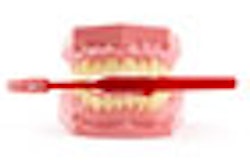Annual prophylaxis, rather than every six months, may be sufficient for patients with no risk factors, according to the authors of a new study in the Journal of Dental Research (June 10, 2013).
Using individual patient risk factors, including genetics, researchers at the University of Michigan in Ann Arbor provided new insights into the frequency of dental cleanings to prevent periodontitis that leads to tooth loss.
Twice-yearly cleanings have been recommended for more than 50 years without supporting evidence, the researchers noted in a university news release. They explored the link between long-term tooth loss and frequency of preventive dental visits (teeth cleanings) in adult patients with and without three key risk factors for periodontal disease: smoking, diabetes, and interleukin-1 genetic variations.
The researchers examined dental claims data from 5,117 adult patients who visited the dentist regularly for 16 straight years, had no history of periodontitis, and consistently received one or two cleanings each year (each patient had insurance coverage for two cleanings annually).
They assessed individual patient risk factors (smoking, diabetes, and genetics) to determine each patient's risk for progressive periodontitis, including testing DNA (Interleukin Genetics) collected from participants for genetic variants that regulate a protein that, when overexpressed, can be associated with periodontal disease and the destruction of bone and soft tissue that support the teeth.
The researchers found that high-risk patients -- those having at least one of the three risk factors -- receive significant benefit in preventing tooth loss from two dental cleanings per year. In high-risk patients with two or three risk factors, more than two cleanings per year may be needed to prevent tooth loss.
In low-risk patients -- those who had no risk factors -- the second cleaning did not have significant value in reducing tooth loss beyond that achieved with one cleaning each year.
The study findings have the potential to improve healthcare outcomes and delivery, according to the researchers.



















